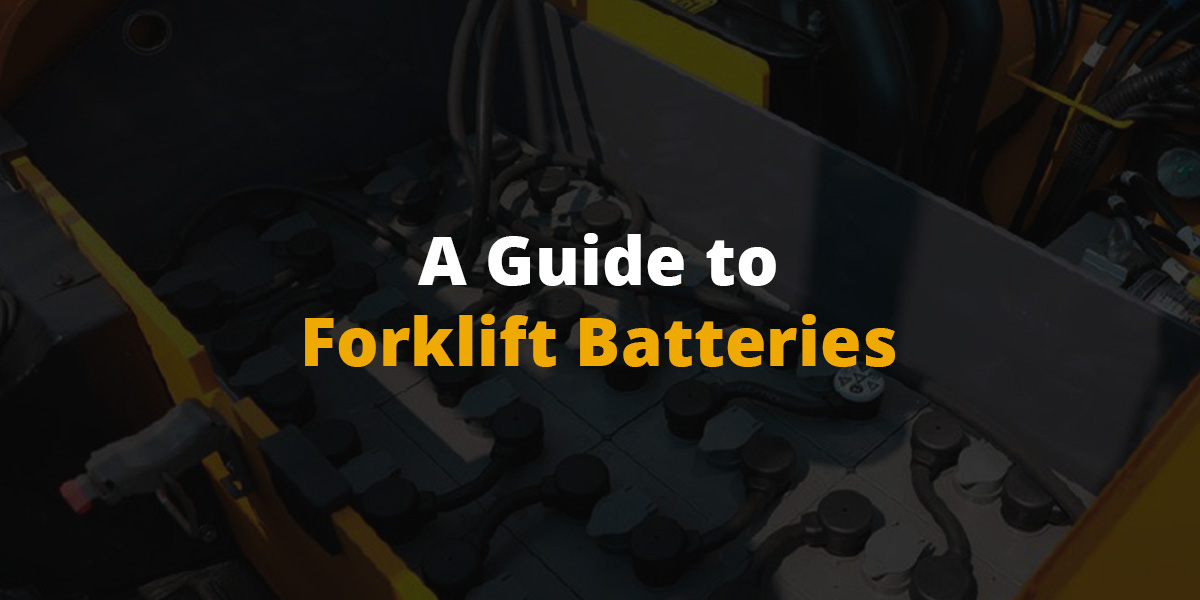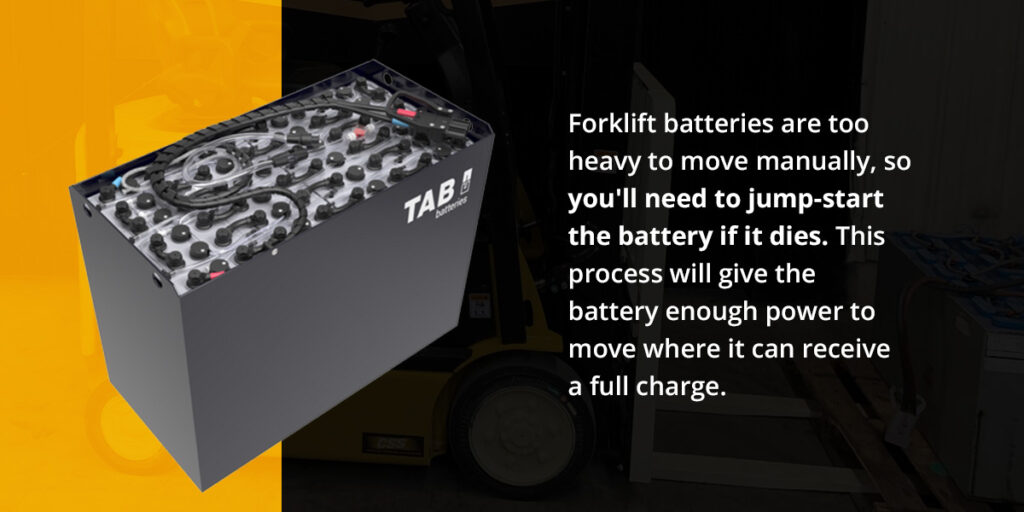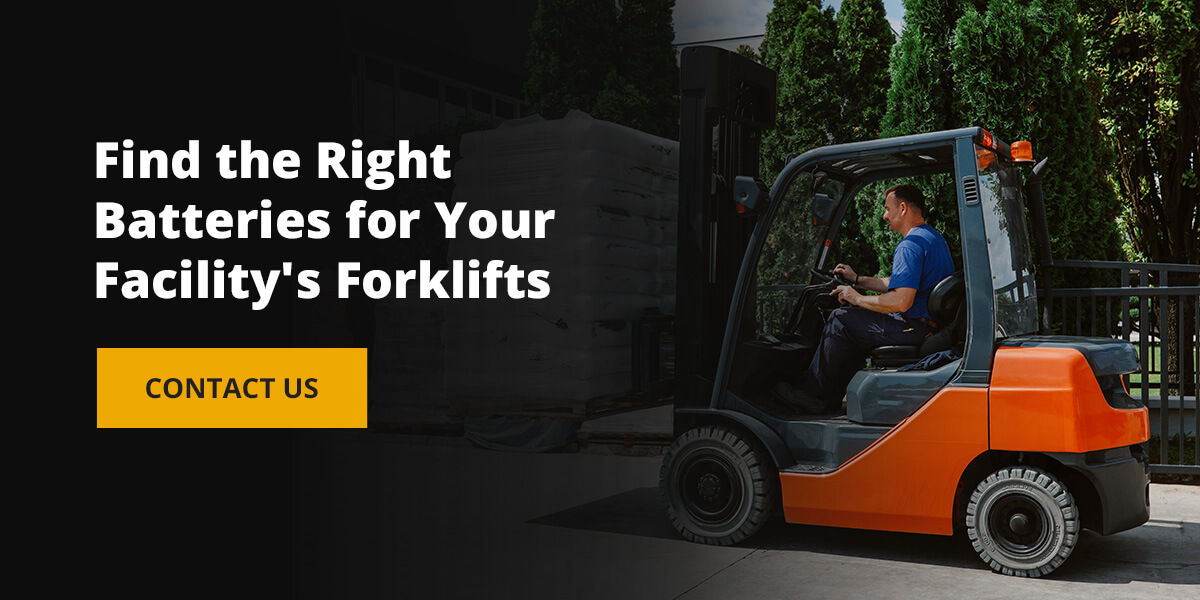
Electric forklifts operate on battery power, making it essential to understand how forklift batteries work and how to maintain them properly. Safety precautions and regular maintenance procedures help keep forklift operators safe, maintain optimal operation and prolong battery life spans.
Whatever type of batteries you use, proper handling can help them remain dependable.
Forklift Battery Types
Electric forklifts can operate on absorbed glass mat (AGM) batteries, lithium-ion batteries or lead-acid batteries. Consider the pros and cons of each battery type before deciding on an option.
Absorbed Glass Mat Forklift Batteries
An AGM battery suspends electrolytes in dry battery plates and transfers them between the plates using a glass mat. Absorbed glass mat batteries are dry-cell batteries, which means they won't spill battery acid if the battery case cracks. This type of battery requires the least amount of maintenance.
It's important to note that AGM battery charge cycles can decrease their performance and shorten their life spans. To extend an AGM battery's life span and ensure it operates at its best performance, make sure it discharges up to 50% of its capacity during each charge cycle. AGM batteries are an excellent choice for companies that don't have specialized electrical grids or want to use batteries with minimal maintenance needs.
Lead-Acid Forklift Batteries
Lead-acid batteries are a type of wet-cell battery and the most common type of forklift battery. Facilities often require specialized electrical wiring to install charging stations because lead-acid batteries have specific voltage demands. A lead-acid battery consists of the following components:
- Water and sulfuric acid mixture
- Battery case
- Cables
- Cells
Lithium-Ion Forklift Batteries
While lithium-ion batteries typically cost more than lead-acid batteries, their benefits make them a popular choice. This type of battery requires no maintenance beyond typical inspection and cleaning. They charge rapidly, and their charge cycles do not affect their performance or life spans. Since lithium-ion batteries are smaller than other battery types, you'll need additional forklift counterweights in the forklift's battery compartment for proper balance.
When Should You Charge Your Forklift Battery?
Since overcharging can hinder battery performance and shorten life spans, you should avoid charging a battery that's already at a full or almost-full charge. It's best to create a charging schedule since forklift batteries often require overnight charging. While overnight charging is typically the best option for single-shift operations, facilities operating on multiple shifts may need to adjust their charging schedules.
How Long Do Forklift Batteries Last?
The length of time a battery charge lasts depends on the following:
- The type of battery
- The battery capacity
- The number of hours it powers a forklift
- Your charging method
Fully-charged forklift batteries are designed to last for full eight-hour shifts before they need recharging, but their activity may affect how long they last. Forklifts that perform minimal operations may last longer, while those with a heavy workload may deplete sooner.
Each battery's manufacturer's guide lists its expected life span. However, improper maintenance and charging can shorten the life span, while proper practices can extend it.

How to Charge a Dead Forklift Battery
Forklift batteries are too heavy to move manually, so you'll need to jump-start the battery if it dies. This process will give the battery enough power to move where it can receive a full charge.
Follow these steps to jump-start a battery safely:
- Check the fluid levels and add enough deionized or distilled water to cover the battery's plates if necessary.
- Move an operating lift close to the dead battery, shut the machines down and engage their parking brakes.
- Attach the red cables to the positive terminals.
- Use the black cable to connect the functioning battery to a solid metal object located 18 inches or more away from the storm.
- Allow the functioning forklift's engine to idle for a while, then run the dead forklift's engine for a few minutes.
- Remove the black cable from the metal object, then remove it from the negative terminal.
- Remove both red cables.
What Kind of Maintenance Does a Forklift Battery Need?
It's crucial to regularly water lead-acid batteries to ensure that deionized or distilled water covers the battery plates. Regularly watering lead-acid batteries helps maintain proper electrolyte levels. A lead-acid battery can typically last five or more years with proper watering.
AGM batteries don't require watering because their electrolytes are suspended in a dry state. Lithium-ion batteries also require no watering, but you should always ensure forklift operators know to keep this type of battery out of high heat and avoid storing it on a full charge.
In addition to watering, all types of forklift batteries require inspections, cleaning and equalizing. Eliminate chemical buildup by thoroughly cleaning the top of each battery once a month. Equalize your forklift batteries once per week, overcharging them to mix electrolytes, remove plate sulfation and balance cells.
You should also visually inspect the battery's connectors and cables regularly. Replace missing parts or contact a professional if you notice any of the following during inspection:
- Cracked or deformed connectors
- Broken connectors
- Exposed wire cables
- Worn cable tips
- Degraded intercell connectors
- Cuts, rust or corrosion on the protective cases
- Missing vent caps
Forklift Battery Safety Tips
Safety is crucial to decrease the risk of hazards such as explosions, shocks, chemical burns, thermal burns and crushing when working with forklift batteries. You can keep yourself and others safe with the following tips:
Proper Environment and Clothing
It's vital to maintain distance between yourself and the battery while moving it to reduce the risk of crushing your hands, feet or fingers. Only charge batteries in well-ventilated areas so air can circulate properly and ensure charging installations are safe from trucks.
You should also keep a phone available in the charging area in case you need to call for help in an emergency. You should also always wear the following personal protective equipment:
- Face shield or goggles
- Apron
- Gloves
- Hard hat
- Safety footwear
Safe Charging
The following safety recommendations will help maintain safe charging procedures at your facility:
- Keep all metallic items, such as jewelry and tools, away from the charging area to prevent electric shock.
- Keep the battery covers open while charging to facilitate proper heat dispersal.
- Never add acid to a battery, and only add water after a battery charges and cools.
- Always turn the battery charger off and unplug it before detaching or attaching the connector.
- Turn the charger off immediately if you see any leaks or notice that the battery temperature increases — you can continue at a lower charge after the battery cools.

Find the Right Forklift Battery Type for Your Facility
Proper charging, handling and maintenance can extend your forklift batteries' life spans and ensure your forklifts operate effectively. Investing in high-quality batteries keeps your forklifts working when you need them to.
Fitzgerald Equipment Company offers top-quality electric forklift batteries from the EnerSys product line. We have been providing trusted equipment since 1962, and we're committed to delivering excellent customer service. We treat each client like a member of our family and ensure we match them with the products that meet their needs. Contact us to learn more and purchase batteries for your forklift fleet.



